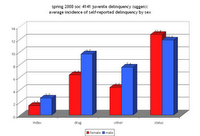 grant duwe of the minnesota department of corrections emailed today with news of an opening for a research analyst. the department is doing some innovative research these days, so the job would be intellectually rewarding as well as remunerative.
grant duwe of the minnesota department of corrections emailed today with news of an opening for a research analyst. the department is doing some innovative research these days, so the job would be intellectually rewarding as well as remunerative.
Research Analyst Specialist – Minnesota Department of Corrections (St. Paul, MN)
Open Period: February 11, 2008-March 14, 2008
Position: Full-time permanent
Salary Range: $18.72-$27.46 hourly
Job Duties: This position will be responsible for evaluating correctional programs and conducting research on sex offenders, offender re-entry, and restorative Justice.
Minimum Qualifications Required:
* Graduate degree (Master’s or Ph.D.) in the social sciences (Criminology, Criminal Justice, Sociology or similar) with advanced training and/or professional experience in quantitative and qualitative research methods and multivariate statistics.
AND
* Demonstrated ability to write research reports for a variety of audiences, as evidenced by the preparation of legislative reports, program evaluation reports, or publications in peer-reviewed academic journals.
* Demonstrated ability to use SPSS, SQL or Access in combining multiple data sets into one final database to conduct bivariate and multivariate statistical analyses.
* Human relations and strong written/oral communications skills essential to work with department managers and staff, research and corrections professionals in the community and other state agency staff.
* Experience managing multiple research projects.
Preferred Qualifications:
* Experience in the criminal Justice system and field of corrections.
* Knowledge of advanced multivariate statistical techniques (e.g. logistic regression, poisson regression, Cox proportional hazards models) commonly used in corrections research.
* Demonstrated ability to design surveys and use appropriate statistical techniques to analyze and interpret survey data.
To apply: go to http://www.doer.state.mn.us/ and get your resume in Resume Builder. Save it and submit it into the database. Search for Job posting number: 08CORR000034. The job posting can also be found here.




 saturday’s
saturday’s 

